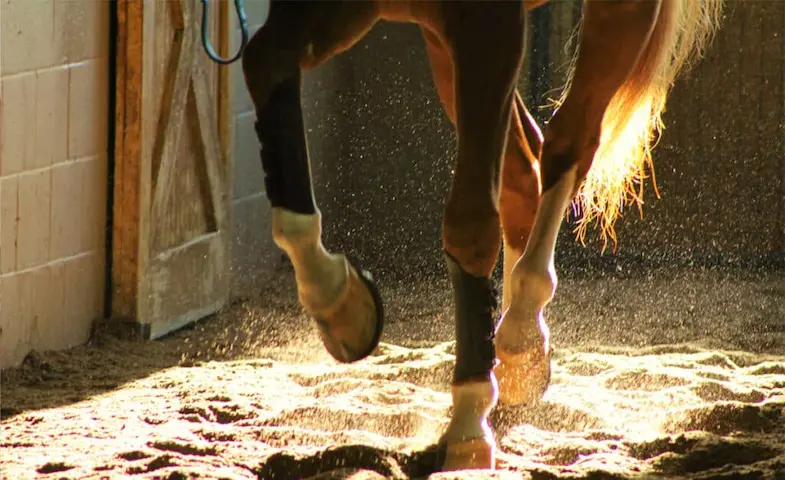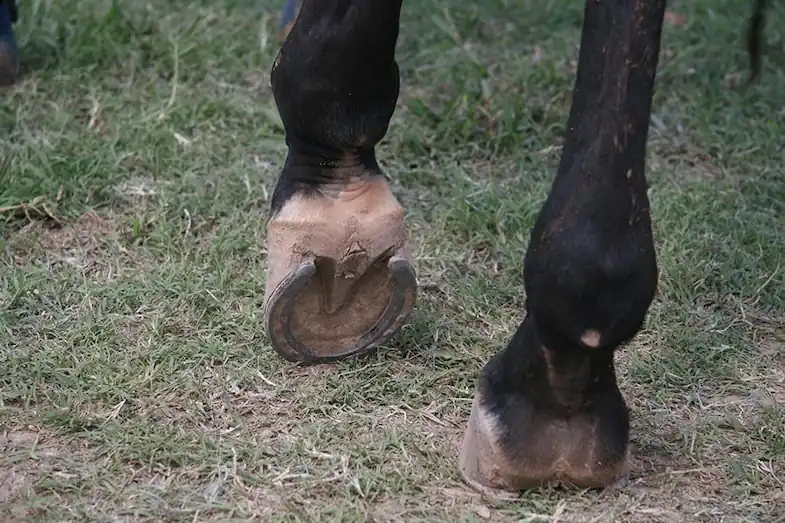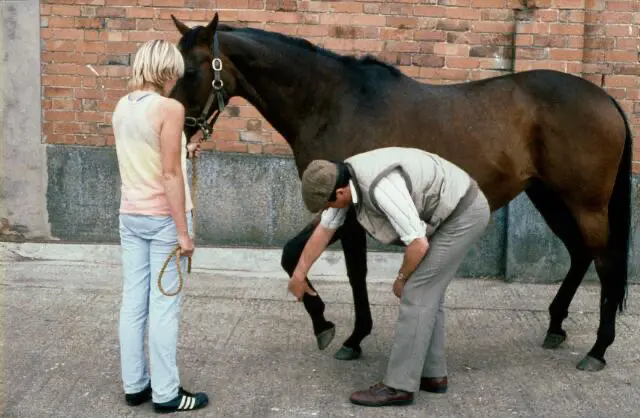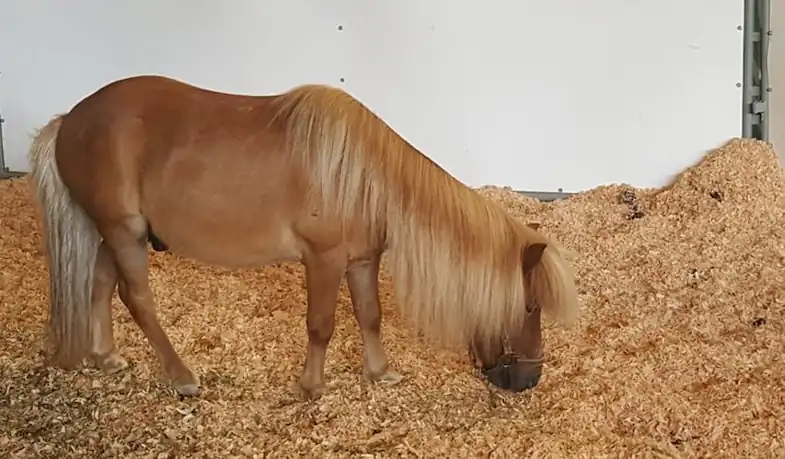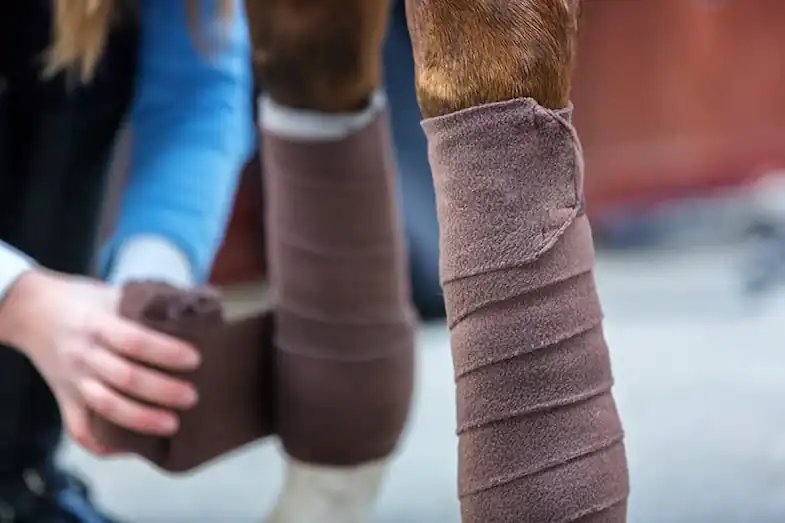Despite being one of the most common ailments that afflict horses, lameness is sadly also one of the most misunderstood conditions. Something that you may find surprising when you consider that it’s the number one reason for loss of performance (and sometimes even retirement) in all horses, not just those in competition. This is why I wanted to write this article, to answer some of the most commonly asked questions and hopefully dispel some of the myths out there.
Many people think of lameness as a disease but this isn’t actually the case. Lameness is an effect of pain, mechanical restriction, or neuromuscular disease rather than a cause. This results in the horse having an abnormal gait.
By far the most common cause of lameness in horses is some sort of pain but you might be surprised to know that the pain doesn’t necessarily have to be in the leg. Even something like a poorly fitted saddle can, if it’s pinching in the right (or wrong) place, catch a nerve that can send a wave of pain down the horse’s leg and make it difficult for him to put any weight on it. That said though, just because pain is the most common source, it doesn’t mean that there aren’t other reasons for a horse suffering from lameness.
What does it mean when a horse is lame?
In short, lameness is a general term that’s used to describe any horse that has a stance or gait that is different from what is normal for that horse but while that might explain what lameness is it doesn’t do anything to explain what causes it or what it actually means for a horse to be lame. Contrary to popular belief it can also affect all horses regardless of their age, breed, type, or even level of work.
Probably the most common cause of lameness is pain although mechanical restrictions, infection, injury, and even congenital defects can all cause lameness.
Horses can suffer from lameness in any of their legs but it’s far more common in the forelegs. It can also occur at any point along the leg, from the hoof to the shoulder (and even through to the neck or back) but 95% of cases of foreleg lameness happen below the knee while in the hind leg it’s more likely to be in the upper leg (typically in the hock or stifle).
How can you tell if a horse is lame?
All horses are different and will display different signs and symptoms but as a rule, most horses that are lame will be unwilling (or unable) to place weight on the problem leg, will bob their head as they move, and may also appear to limp as they walk or trot. This in itself though doesn’t mean that your horse is lame, they may just have a stone in their shoe so if your horse is showing these signs it’s important to check their hooves.
If your horse is limping and bobbing his head you should firstly check him over to make sure there’s nothing else that’s causing him to limp. You should check him from head to toe but pay close attention to:
- Hooves: Make sure there are no stones or debris in them as well as to look for any cracks or dark spots that could indicate an injury, damage, or bruising.
- Lower legs: Make sure they’re not hot or swollen and if they are, look out for any obvious cuts, wounds, or scratches.
- Standing: Pay attention to how your horse is standing, is he putting more weight on one of his legs or is he reducing the weight on a particular leg?
- Joints: Lift each leg in turn and carefully move it through the full range of movement while looking for signs of pain or discomfort.
- Neck & back: Run your hands over them to check for any swelling or localized heat while also watching your horse for signs of flinching, this will help you to tell whether there might be an infection or not.
- Gait: If possible have somebody walk and trot your horse away from you (and back), in most cases, this will make it easier to tell if your horse is really limping or if he’s just not loosened up yet.
Not all horses will bob their head or show outward signs of limping which is why many horses are sadly ridden while suffering from pain. Other less common signs of lameness in horses are an increased heart or respiration rate, restlessness (especially in the stall), standing on softer surfaces more. Some horses may also pull their leg back and then almost slapped it back down (although this is more common in mechanical lameness).
If your horse is showing signs of lameness (or if you suspect he is) you should speak to your veterinarian immediately, they’ll be able to properly diagnose your horse and will also offer the best course of treatment.
What causes a horse to go lame?
Lameness is a clinical sign rather than a condition in itself which means that there can be a large number of causes (along with just as many forms of treatment) and while the signs can be obvious the cause can only be properly determined by a veterinarian. By far the most common cause of lameness is some sort of pain, but other common causes are:
- Laminitis
- Injury (either to the hoof or leg)
- Infection (such as foot abscess)
- Sprain or fracture
- Degenerative disease (such as arthritis)
- Back and neck issues
- Congenital defects
- Metabolic disorder (such as EMS)
- Abnormalities in the nervous system
How can you diagnose lameness in a horse?
It can be difficult to properly diagnose the cause of lameness, in part because many causes share the same symptoms, while some don’t have any obvious signs. This is why your veterinarian will carry out a number of tests and examinations in order to make a proper diagnosis.
Every veterinarian is different and many have their own methods for diagnosing lameness but in general, they will follow a similar path to the one below:
- Medical history: They’ll want to know about any previous issues the horse has had as well as the current problem. Most veterinarians will also want to know about the horse’s exercise routine.
- Visual examination: They’ll look at how the horse is standing, how he’s balanced and his conformation, they’re also looking for any signs of injury or trauma.
- Physical examination: They’ll feel the horse’s limbs, muscles, joints, bones, and tendons for any signs of pain, heat, swelling, or anything else out of the ordinary.
- Hoof tester examination: This is a test that uses a specialist pincer-type instrument to apply pressure to the soles of the hoof in order to check for unusual sensitivity or pain.
- Observation of gaits: They’ll ask you to walk and trot your horse up and down (typically on a hard surface) while they observe the horse from a variety of angles. This gives the veterinarian a chance to notice any deviation in the gait as well as any unusual shifting of weight.
- Joint flexion: This involves the veterinarian holding the leg in a flexed position and then releasing it before asking the handler to move the horse away in a trot. While the horse is moving away they’re looking for any sign of pain, change in movement, or shifting in weight.
- Diagnostic anesthesia: Only used if pain is believed to be the cause of lameness, this is a nerve block that is injected into the nerve or joint to help determine the source of the pain.
How can you help a lame horse?
If you suspect your horse is lame you should speak to your veterinarian as soon as possible, they will first be able to determine the reason for the lameness and then provide you with the best course of treatment. Until your veterinarian has assisted your horse and diagnosed the cause of his lameness though there are a few things that you can do to help ease the pressure on his leg or hoof.
- Clean hooves: Making sure your horse’s hooves are free from any debris will not only reduce the pressure on his hooves but could completely eradicate the lameness. If this is the case then you won’t need to speak to your veterinarian at all.
- Keep stabled: You might think that keeping your horse confined to his stall isn’t a good idea but doing so while he’s lame will help to reduce the chance of him causing more damage.
- Provide cushioning: Many horses with lameness will choose to stand on softer, padded ground so providing them with a thicker layer of bedding will offer that extra level of cushioning. The only condition I’ll add though is that, depending on the type of bedding you use, you’ll have to make sure it doesn’t compact in your horse’s hoof.
- Don’t ride: It may sound like the most obvious thing to say but riding your horse will only put extra (and unnecessary) pressure and weight on him which is likely to make the lameness more painful, if not worse.
How should you treat lameness in a horse?
There’s a lot of misinformation online with companies selling ointments and treatments that will cure all horses of lameness but sadly there is no such thing as a miracle cure. There isn’t a single cure for all horse because the treatment is dependant on the cause which is why it’s crucial to speak to your veterinarian. They’ll be able to give you a proper diagnosis as well as a treatment plan that is very likely to work.
After all, if your horse’s lameness is caused by some sort of infection there’s no point in padding the leg and wrapping a splint around it. Likewise, if your horse is lame because he has a congenital condition (such as contracted tendons) then treating him with analgesics and anti-inflammatories will have no effect.
Can you prevent lameness in horses?
We’ve all heard the saying that prevention is always better than cure and lameness is by no means an exception and there are a few simple steps that you can take to reduce the chances of your horse becoming lame.
Make sure you have the right horse
Every horse is different and they all have their own conformation depending on their breeding or their type and this should be taken into account when choosing the right horse for your needs. It might sound selfish and that you’re putting your needs before those of your horse but it could greatly reduce the chances of them becoming lame due to overstraining.
Proper hoof care
Looking after your horse’s hooves is crucial for preventing lameness. Make sure you remove all of the mud, dirt, and debris (as well as manure and bedding) from his feet every day, paying close attention to the frog and interior. You should also check your horse’s outer hooves and shoes (if he wears them) every day, keeping an eye out for anything out of the ordinary such as odors or discharge. Calling your veterinarian or farrier as soon as you see any sign of infection or a deep crack will also help to prevent lameness.
Regardless of whether or not your horse wears shoes, he should have his hooves checked every six to eight weeks. This will help to keep his feet balanced and properly aligned, therefore reducing excessive strain on the muscles, tendons, and ligaments, not to mention the hoof itself.
Soft bedding
Standing for long periods of time on hard surfaces such as concrete is known to cause strain on a horse’s leg which can, in turn, lead to lameness. Yet by making sure there are no bare concrete patches in the stall can go a long way to cushioning your horse’s feet. The ideal bedding option would be a bottom layer of rubber matting with a thick upper layer but if this isn’t possible make sure your horse has thick bedding to cover the whole floor.
Be mindful of where you ride
While it’s not always possible to choose the ground you’re riding on (especially if you’re riding away from home a lot or are competing) but if you have an arena then covering it with something like sand will really help to cushion your horse’s footing. This is even more important if you’re a jumper or reiner (or involved in any other high-impact sport).
You should also avoid riding on hard ground (such as blacktop or concrete) for prolonged periods of time as the constant pounding on your horse’s hooves can cause lameness.
Check your saddle
I know that this is often the first thing many people say when talking about any issue with horses but a properly fitted saddle is crucial for so many reasons, not just for lameness. If your horse’s saddle isn’t fitted properly then, over time, it can cause pressure points and back pain that can lead to lameness.
Warm up / Cool down
We all know that we should spend 10 to 15 minutes warming up before a ride and then the same amount of time warming down afterward but very rarely do it, yet if we knew that doing so could help to prevent lameness I’m sure we’d feel differently. The reason this works is that it helps to warm up the muscles as well as encourage proper blood flow, reducing the chances of strain and therefore lowering the risk of lameness.
Leg protection
You might think that leg protection is just a fashion choice (or the reserve of jumpers) but it can help to protect your horse’s legs. Bandages won’t prevent all damage but they’ll reduce the chance of serious injury which could lead to lameness.
Be cautious when turning your horse out
While horses are generally pretty surefooted turning them out when the ground is wet and muddy can increase the risk of them slipping which could result in pulled muscles or torn ligaments and therefore increasing the chances of lameness. I’m not saying don’t turn your horse out in the winter, just be wary of the weather and if possible (or necessary) lay straw or sawdust over the mud to help absorb some of the moisture from the ground.
Related question
What’s the difference between lameness and unsoundness?
Many people misunderstand lameness and unsoundness, thinking that they’re just different names for the same thing but this couldn’t be further from the truth. While both conditions can afflict any horse of any age, lameness is an issue that will only affect a horse short term. Unsoundness on the other hand can (and often does) affect a horse throughout its life and can be used to describe a range of ailments, not just those of the leg.
Further reading
- Beginners guide to horse care
- Do horses need to wear shoes?
- How much water do horses need?
- Equine Cushing’s disease explained
- When should you retire an old horse?
- Mud fever: your questions answered
- Preventing sunburn in horses
- Why horses show their teeth
I hope you found this article helpful. If you did I’d be grateful if you could share it please as it would really help me.
Recommended products
Over the years I have tried hundreds of different horsey products, from various blankets and halters to different treats. Some I’ve loved, others I’ve hated but I thought I’d share with you my top all-time favorite products, the ones I never leave the yard without. I’ve included links to the products (which are in no particular order) that I really think are great.
- Horse Knots by Reference Ready – If you’re like me and enjoy pocket reference guides then you’ll love this knot tying guide. These handy cards can easily fit in your pocket or attach to the saddle for quick reference. They’re waterproof, durable and are color coded to make them easy to follow.
- Mane ’n Tail Detangler – Even if you never show your horse you’ll need to detangle his tail from time to time (and possibly his mane too) which is always a challenging chore! I’ve found that if I run a little bit of detangler through my horse’s tails every few days it stops them from getting matted up and makes combing them easy, even if they’re coated in mud. I don’t know if I should admit to this or not but it also works wonders on my hair.
- TAKEKIT Pro clippers – Over the years I’ve tried a lot of different clippers and while some were obviously better than others I found these to be by far the best. They are heavier than a lot of other clippers but for me, that’s a good thing, it makes them feel more sturdy and hardwearing. On top of that they have a range of speeds so are just as good for clipping your horse’s back as they are his face. I also like the fact that they come in a handy carry case but that’s not for everybody. The company that makes them is super good and incredibly helpful too, a real bonus these days. The only thing I wasn’t keen on was the fact that it doesn’t come with any oil, but that’s not a major problem as it’s not difficult to buy lubricant.
- Shire’s ball feeder – There are so many boredom buster toys out there but I like to use these every day, regardless of whether or not my horses are bored. I find that it helps to encourage my horses to problem solve by rewarding them with treats (or pieces of fruit) but it also mimics their natural grazing behavior which helps to keep them calm and de-stressed.
- Horse safe mirror – This is a strange one that many people are surprised about but I like to put horse safe mirrors in the trailers as well as in the quarantine stalls. It helps to prevent the feeling of isolation by giving the impression of other horses being around. Being herd animals horses can get extremely stressed when they feel that they’re on their own but with these stick-on mirrors, they believe that at least one other horse is with them.
- Rectal thermometer – I know this isn’t glamourous at all but it’s vital for your horse’s well-being to be able to check their temperature and a rectal thermometer is the easiest way of doing this which is why I’ve added it to the list.
Shopping lists
I’ve also put together a few shopping lists of essential items that I’ve found helpful over the years. I’ve broken the lists down into different categories rather than put everything in one massive list 😉

